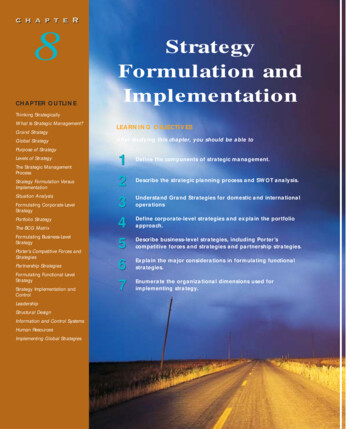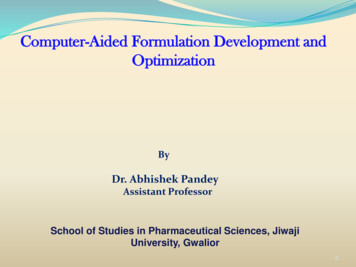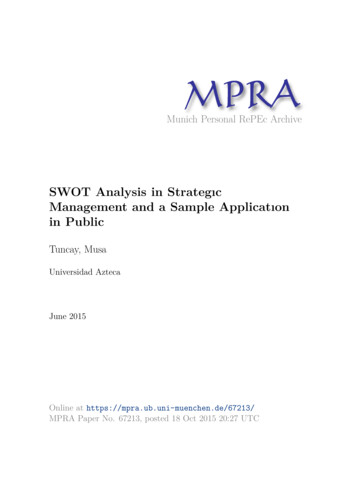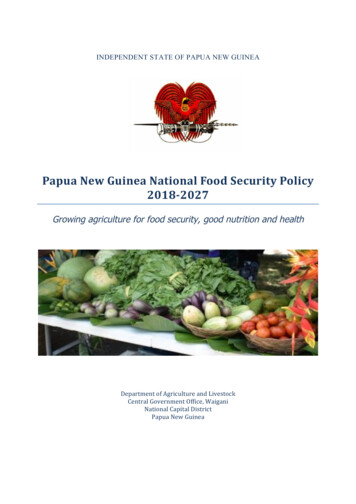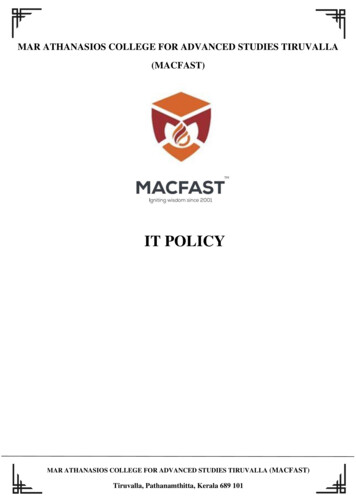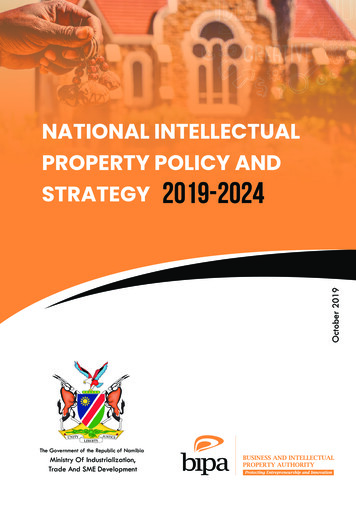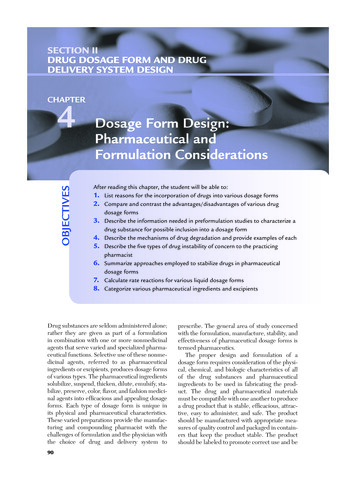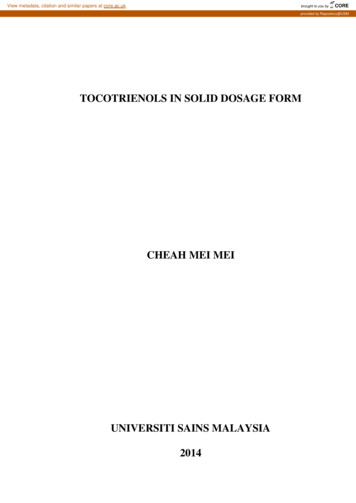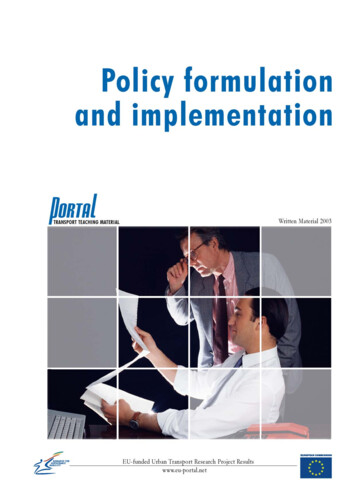
Transcription
Policy Formulation and ImplementationPORTAL Written Material1www.eu-portal.net
For the use of the following material:The aim of PORTAL is to accelerate the take up of EU research results in the field of local andregional transport through the development of new education and training courses and teachingmaterials. The beneficiaries of the project are higher educational institutions.Due to the size and (in some cases) the number of individual projects, it is not possible toexplain each single result in detail and include it into these written materials.The following set of material should rather act as a PORTAL and facilitate the access of singleprojects and detailed results by the lecturers.Therefore the material in hand doesn't lay claim to completeness.Since the expectations of the lecturers regarding these materials are quite diverse - theexpectations run the gamut from 'providing a survey of the result of the EU-research to aspecific topic' to 'providing special results of a single research-project in detail' -, the attempthas been made to make a compromise and (more or less) come up to the expectations of all usergroups.The following compendium contains results of EU research-projects and complementary resultsof national research-projects. PORTAL thanks the partners and collaborators of the followingprojects. A complete list of the projects, consortia, and cited literature is given at the end of thematerial.This material of project results for the topic “Policy Formulation and Implementation” wascompiled by Sandra HANZL, Michael MESCHIK and Gerd SAMMER (Institute for TransportStudies, University for Bodenkultur Vienna) in 2001 and adapted after a workshop withlecturers in cy Formulation and ImplementationPORTAL Written Material2www.eu-portal.net
Table of Contents1.Introduction .51.11.21.31.41.52.Definition of Policy Formulation & Implementation . 5Objectives and skills. 8Challenges . 9Link with EU policies . 9Description – summary of the contents . 10Policy Formulation. 112.1 Problem analysis. 14Objectives and Goals . 15Deficiencies . 16Indicators . 172.2 Measures. 182.3 Scenarios and alternatives . 20From measures to scenarios . 20How to use scenarios . 22Contents of scenarios . 23Determination of the impacts . 23Examples . 253.Implementation. 303.1 The process of implementation . 313.2 Measures. 333.3 Barriers - Acceptability . 344.Planning & project management . 385.Participation . 445.15.25.35.45.56.Awareness raising & public relations . 516.16.26.36.46.56.67.Goals and principles in the planning process . 44Preparation . 45Participants. 46Communication and information . 47The process . 49Goals . 51Information and messages . 52Target groups . 54The process of awareness raising. 55Measures and instruments . 59Strategies . 59National Differences . 65Policy Formulation and ImplementationPORTAL Written Material3www.eu-portal.net
8.Conclusions and recommendations . 679.Exercises . 6810. Literature. 6911. Glossary. 7212. Policy Formulation and Implementation – The consortia of theprojects . 73Policy Formulation and ImplementationPORTAL Written Material4www.eu-portal.net
1. Introduction1.1Definition of Policy Formulation & ImplementationPolicy Formulation stands at the top of the transport planning process. It is a strategic planningprocess leading to a general concept, usually a “Transport Masterplan”. Such a masterplan is apolitical decision. It includes a set of measures aimed at the future developments of the transportsystem. A consensus has to be found on which scenario or group of measures out of differentscenarios and bundles of measures is apt to fulfil the intended goals in the best way. This overallconcept normally is a legally-binding framework for more detailed plans and concepts for alonger period of time.Policy Formulation is most important at higher strategic levels but has to be considered at eachlevel of a transport planning process: Strategic policies in transport cover a larger area and include long-term strategies. Thesepolicies have to be far sighted and consequently implemented. Regional and local transport policies are applied on regions and small areas (towns,villages, etc.), following the overall principles of a general concept – however on a smallerscale.The differences between the various levels - national, regional, local – appear in the allocationof authorities and competence and in the extent of impacts and effects.Participation and information of all involved parties should be regarded as an important aspectto gain accepted goals and accepted policies. One problem of environmentally sound policies isthat the measures to achieve transport systems heading towards sustainability are in most casesunpopular.All transport policies should basically have common features such as: inclusion of all affected parties (transport operators, transport users, politicians, etc.); inclusion of all affected aspects (transport, modes of transport, health, environment, socialpolicies, economics, etc.); approval of a majority (voters, experts, etc.); strategic view, logical and consistent layout and implementation over longer periods; possibilities to (re)adjust the policies based on feedback and evaluation, etc.Policy Formulation and ImplementationPORTAL Written Material5www.eu-portal.net
Implementation is normally regarded as a vital and often neglected phase of strategic planning.“The implementation encloses all actions that take place during the realisation of the plans, i.e.budgeting, construction of infrastructure and the undertaking of necessary institutional changesfor policy measures (TENASSESS 1999, Annex II)”.It is essential that implementation also comprises the analysis of social and politicalacceptability of measures and the sensibility of citizens, politicians, journalists and experts forobjectives and programmes before, during and after implementing transport measures. Publicawareness and information campaigns as well as the installation of a permanent marketingprocedure may help to enhance the acceptability of transport plans or single measures.Quality control – concerning acceptability as well as functionalism of implemented measures –provides the possibility for readjustment, improvement and reaction.Figure 1 gives an overview on the dependencies of policy formulation and implementation andemphasises the definition of this key topic. Figure 2 exemplifies a planning process – frompolicy formulation to implementation – with a parallel communication and participationprocess.Key topicsPolicy Formulation intransport planningSteps of the processStrategic planning processOutputTransport policy formulationGeneral concept of measuresTransport MasterplanPoliticalDecisionPlanning process of the allocatedmeasuresPoliticalImplementation oftransport measuresDesign of the measuresDecisionImplementation processConcept of implementation Information Awareness raisingRealised / implementedmeasuresEvaluation of success,Quality controlFigure 1: Overview from the strategic planning process to the implementation in local or regionaltransport policy (BOKU-ITS)Policy Formulation and ImplementationPORTAL Written Material6www.eu-portal.net
Planing ProcessComunication and participationprocessProblem analysisProject organisation, citizensassembly, etcScenarios and developmentof measuresProject meeting with workinggroupsEvaluationDiscussion and report to thecitizens about impacts/effects;citzens‘ assemblyImplementationDetailed planningWorking groupsPolitical decisionQuality controlReport to the citizens aboutsucessFigure 2: Example of policy formulation leading to a political decision and to implementation(SAMMER, ROESCHEL 2000)Figure 3: Detailed planning as one part of the whole transport planning process.Policy Formulation and ImplementationPORTAL Written Material7www.eu-portal.net
The basic structures and the important ingredients of Policy Formulation and Implementationprocesses in transport planning are shown in figure 4.Transport PlanningPolicy FormulationImplementation Planning process. Realisation of definedmeasures/ plans Goals of policy formulation. Problem analysis. Paying attention to social& political acceptability Development of scenarios. Quality control Etc. Etc.Tools for Policy ojectManagementAwarenessraisingEtc.Tools for tAwarenessraisingEtc.Figure 4: Structure / contents of Policy Formulation and Implementation (BOKU-ITS)1.2Objectives and skillsThe main objective of this key topic is to show the important position of policy formulation andimplementation within the planning process, their interdependencies and the importance ofparticipation and communication during policy formulation processes as well as during theimplementation phase.The students should gain basic knowledge of: the steps of policy formulation and implementation processes embedded in the planningprocesses on basis of structured charts, practical and concrete examples; the importance of formulating strategies and goals in transport policies; tools and instruments in the planning process; different measures in transport policies apt to influence the transport situation and trafficbehaviour;Policy Formulation and ImplementationPORTAL Written Material8www.eu-portal.net
participation processes in transport planning (policies) and awareness raising; scenario technique and the importance of prognoses; project management and evaluation of the grade of achievement of the goals.1.3ChallengesPolicies to reach defined aims are well known and documented – the main problem is theirimplementation – not in terms of building a road or enacting a new law – but to convince theinvolved parties, mainly the citizens, and to gain their awareness and acceptance. To defineaccepted goals which comprise accepted measures is the main challenge politicians and plannersare facing. The focus of this studying material is therefore on planning, sociological, politicaland organisational issues. Awareness raising plays an important role, too. Technical, financial,legal and regulatory subjects are dealt with casually.1.4Link with EU policiesThe White Paper of the European Union on European transport policy (COMISSION OF THEEUROPEAN COMMUNITIES 2001) forms the framework for transport policies in the memberstates. It is based on a long-term strategy with the overall target of developing a sustainabletransport system - an ambitious objective considering the growing problems in transport, likeworsening congestion, damage to the environment, isolation of some regions, etc. caused by theincreasing demand for motorised mobility.Such a long-term strategy takes time and the aid of numerous measures and policy instruments.The White paper gives a proposal about 60 specific measures which should be implemented by2010 to redirect the common transport policy towards meeting the need for sustainabledevelopment.The analysis in the White paper stresses: the risk of congestion on the major arteries and regional imbalance, the conditions for shifting the balance between modes, the priority to be given to clearing bottlenecks, the new place given to users, at the heart of the transport policy, the need to manage the effects of transport globalisation.The focus thereby is not only on transport policies – an integrated approach taking into accountconsistent measures in the context of other policies like economic, urban and land-use planning,social and education, budget and fiscal policies is more promising – provided the member statesdecide to accept the need of change and do not stick to the status quo.The choice for a sustainable development will require the adoption of pro-active measures,some of them difficult to accept, as well as the implementation of new forms of regulation tochannel future demand for motorised mobility. This course, the EU is pursuing, has to becontinued by the member states, from the national to the local authority, being aware of thechallenge and responsibility they are facing for the future development in Europe.Policy Formulation and ImplementationPORTAL Written Material9www.eu-portal.net
Beside the White Paper, which mostly intends to give recommendations and directions, the EUproject TENASSESS (1999) provides a good insight into transport policy in Europe.1.5Description – summary of the contentsPolicy Formulation and Implementation are both central parts of the strategic planning process.Whereas policy formulation stands at the top and builds up the framework, implementation is adirect consequence of the decisions so to speak of the output of policy formulation.Several tools exist for both parts which assist in achieving their goals and which support theforthcoming and success of the process. Scenario technique is the vital one for policyformulation, control of success the one which provides the necessary quality of implementation.Both share the tools participation, awareness raising & public relations and projectmanagement. Project management ensures a consistent course of events, whereas participationand awareness raising target at the overcoming of political and especially social barriers and atguaranteeing success of transport projects, plans, implemented measures, etc. under the aspectof acceptance.The structure of the studying material follows this approach. Policy formulation andimplementation as the cornerstones are described and explained particularly, the three mutualtools (participation, awareness raising & public relations and project management) are dealtwith in individual chapters each. Each chapter can be used as a module and can besupplemented by the others.Policy Formulation and ImplementationPORTAL Written Material10www.eu-portal.net
2. Policy FormulationPolicy formulation in the field of transport planning is a process to: develop, discuss and settlethe strategy and goals of a transport policy. It therefore: is one of the most important parts of the planning process; reflects the system of values the society has towards the status of transport, environment,etc.; is a precondition for the evaluation of transport measures and transport investment.Strategic planning is imperative to upper levels of transport policy where guidelines for lowerplanning levels are given. Yet it should be considered at all levels of the planning hierarchy, atregional, local and urban transport policy. Strategic transport policy includes general ideas andprinciples and is therefore easily based on a consensus. It should, however, include goals whichare to be met in the future as well as a set of measures to achieve these goals. Further, it shouldcomprise indicators at which the level of achievement can be measured. The more concrete (andsmaller) the planning area gets, the more detailed will the transport policies become, and in theend strategic guidelines will lead into concrete and detailed measures - this is the local levelwhere the policies mutate to implementation.The future development of the benefits and of the impacts of transport have to be estimatedunder the given environmental restrictions as well at local levels and at global level (e.g. theKyoto protocol). It is important to develop different scenarios of possible future developments.The desirable scenarios are usually those that show distinct improvements compared with thetrend scenario, which is also known as “BAU”-scenario (business as usual) (figure 5).Current DevelopmentVision of aDesirable FutureCurrent SituationTrend DevelopmentFigure 5: Future development dependent on present transport policy formulation.Source: Drawing Dietiker, looser 1985Policy Formulation and ImplementationPORTAL Written Material11www.eu-portal.net
How can Policy Formulation be presented to the public?Future transport scenarios can be complex models, which are not easily comprehensible to thepublic. It is therefore essential to break the structure down into smaller parts, which are easierunderstandable, and to present the main contents to the public: Model (Leitbild) of the transport policy for a city, community, region, etc; Strategic goals of transport policy; Hierarchical system of goals of transport policy; Quantitative goals, e.g. the target of changes in the modal split for a reference year; Recommendations for transport policy; Etc.Detailed strategic goals and policies for different transport sectors are listed in MAESTRO(1999, Guidelines, Annex A – Annex G).Institutionalised levels of authoritiesThe political, legal and institutional conditions form the framework for transport policiesrespectively policy formulation (and implementation). The different levels of authorities – atinternational, national, regional and local level (table 1) – represent a hierarchy, which has tofulfil the requirements of co-ordination and interaction (TRANSLAND 1999). International (EU) – White Book on European Transport Policy. National – National Transport Plans. Regional – Transport Plan of a Federal State. Local – Plan for regional development (comprising transport issues).Table 1: Policy formulation at different institutionalised levels of authoritiesTools for policy formulationThe following tools are vital for the process of policy formulation (and also in implementation,see chapters further below): Scenario technique Participation of stakeholders of transport policy Information and awareness raising Project managementPolicy Formulation and ImplementationPORTAL Written Material12www.eu-portal.net
Policy Formulation and the transport planning processDifferent modules have to be worked out before a transport policy can be evolved (figure 6).Problem analysisFormulationof objectivesAnalysis ofcurrent situationAnalysis ofdeficienciesDevelopment of measuresCombine measures to alternatives and scenariosDetermination of the impactsof the alternatives and scenariosEvaluation of the alternatives and scenariosPoliticalResult of PolicyFormulation ready forimplementationDecisionTransport Policy – Model (Leitbild)Transport Policy – Goals / objectivesTransport Policy - PrinciplesFigure 6: The process of policy formulation in the transport planning process (BOKU-ITS; adapted fromRVS 2.1, 1984)The steps of this process are described in the following chapters. Some tools which are essentialfor the process of policy formulation are included in chapters of their own (see “participation”and “awareness raising and public relations” respectively). See also MAESTRO-Methodology(MAESTRO 1999) and methodological recommendations of FATIMA (1999).Policy Formulation and ImplementationPORTAL Written Material13www.eu-portal.net
2.1Problem analysisThe problem analysis stands at the beginning of most planning processes. The results form thebasis for all following steps. The main parts of the problem analysis are the: formulation of objectives and goals analysis of the current situation analysis of deficienciesFigure 7 gives an overview on these three parts. The details are described below.Formulation ofobjectivesAnalysis of currentsituationAnalysis ofdeficienciesSurvey of objectives,goals, guidelines.Determination ofnecessary surveys.Survey of deficienciesof the current situation.Deduction of relevantgoals.Carrying out ofnecessary surveys.Selection of the relevantdeficiencies of thecurrent situation.Decision about andfixing of goals.Processing of the data.Operationalizing of thegoals by indicators.Description of thecurrent situation by thedefined indicators.Definition of thedesirable level ofindicators.Operationalizing ofrelevant deficiencies byindicators.Evaluation of thecurrent situation.Figure 7: Flow chart of the problem analysis (BOKU-ITS; adapted from RVS 2.1, 1984)Policy Formulation and ImplementationPORTAL Written Material14www.eu-portal.net
Objectives and GoalsGoals and objectives can be seen from different points of view, depending on the stakeholders.Main goals of a transport policy might be (some examples): Sustainable development of traffic; Handling of traffic in a socially and environmentally friendly way; Good accessibility for all users of all modes; City of short distances; Participation of citizens in all planning processes; Etc.In an environmentally friendly scenario four sets of goals (principles) could be set up(table 2):To avoidUnnecessarytraffic Slowing downthe increase inmotorised traffic.To shiftNecessary traffic toother modes withcomparative smallnegative effects(concerning passengerand freight transport).To improveTo supportConditions for all modesof traffic.Sustainable modes likecycling and walking.AccessibilityReasonable mobility.Supply for sustainablemodes.Road safety.Table 2: Goals in an environmentally friendly scenario (BOKU-ITS)Some examples of goals and their respective indicators are included in the following table 3,representing operators, users and the general public as stakeholders in a transport planningprocess (extracted and summarized from MAESTRO, 1999).Policy Formulation and ImplementationPORTAL Written Material15www.eu-portal.net
StakeholdersGoalsIndicatorsOperatorsMinimal expenses.Capital costs, operating costs.Maximum revenues.Transportation fees, taxes/tolls.Minimal travel time.Travel time.Minimal travel costs.Travel costs.High quality of traffic supply.Level of service, travel comfort, frequencyof service.Maximum road safety.Accident rate, costs, accident density.Minimal environmental damage.Threshold values of emissions of noiseand pollutants ( Effects on climate,water, soil, people).UsersGeneral PublicNumber of persons harmed by emissionsof noise and pollutants.Demand of area.Effects on landscape and townscape –scale from 1 (excellent) to 5 (very poor).Optimal regional planning.Accessibility – Distance to the centre, busstop, etc. for all modes.Effects on population structure (e.g.number of persons past 60).Minimal economic costs of allimpactsTotal economic costs.Table 3: Goals, objectives and indicators from the stakeholders’ point of view (BOKU-ITS; extracted andsummarized from MAESTRO, 1999)A detailed list of goals, objectives and indicators can be found in the EU-project MAESTRO(1999, Guidelines).DeficienciesA current situation can be characterised by comparison with standard values. It is useful whengoals have been laid down in an earlier stage. By the extent of fulfilment of the agreed goals –measured by indicators – deficiencies as well as levels of fulfilment can be determined. Table 4shows an example of such a catalogue of possible deficiencies.Policy Formulation and ImplementationPORTAL Written Material16www.eu-portal.net
GoalExample of a deficiencyTraffic supply for pedestrians.Missing crossing aids.Traffic supply for cyclists.Dangerous junctions.Traffic supply for Public Transport.Insufficient bus schedule.Traffic supply for private vehicle traffic.Congestion.Road safety.High risk sites.Emission of exhaust gases.Heavy pollution on main roads.Immission of noise.Exceeding of the threshold value of noise inresidential areas.Table 4: Possible deficiencies of a current situation (BOKU-ITS)Figure 8: Does this picture show any obviousdeficiencies?IndicatorsIndicators are being used to quantify the status of a project or the progress / failure inaccordance with a set time-schedule (see also “Implementation”).Definition: An indicator describes the quantitative or qualitative impact of the current transportsituation and of transport measures. It can be used to describe the strength of deficiencies of thecurrent situation and the performance of measures towards desirable goals etc. It shouldtherefore have a unit to allow comparisons on an agreed level ([cars/h], concentration/m³],[numbers/km], etc.).Application: An indicator can be used to describe the strength of deficiencies of the currentsituation and the performance of measures towards desirable goals etc.Policy Formulation and ImplementationPORTAL Written Material17www.eu-portal.net
Examples of indicators and possible units shows table 5:IndicatorUnitTraffic volume for different modes[Trips/24h]Modal SplitModal choice [%]Traffic volume[Cars/24h]Accessibility of the city centre for all modes[m or min]Road safety for private vehicle traffic,pedestrians and cyclistsAccident rateDemand of area for parking lots[m²]Noise nuisance[numbers of people affectedby dB (A)]Exhaust gas load[t/d]Table 5: Examples of indicators (BOKU-ITS)The EU-project SESAME (1998) provides a selection of relevant indicators of transport, traffic,land use and relevant externalities for transport and land use planning.2.2MeasuresMeasures are the modules of transport (master)plans. They represent the goals and their successcan be measured by indicators which were both fixed in a previous step of the policyformulation. Note that the goals that should be achieved have to be chosen before the measuresare developed. Measures can be small or big, individual or global. Measures in transport can bestructured in different groups. Transport infrastructure (hardware) Organisational transport measures (software) Information and awareness raising Accompanying measures outside the transport fieldPolicy Formulation and ImplementationPORTAL Written Material18www.eu-portal.net
Table 6 gives an overview on groups of transport measures, which can be arranged to bundles ofmeasures mutually to correspond with the chosen ationaltransport measures(Software)Information andAwareness raisingAccompanyingmeasures outsidethe fields oftransportsDevelopment of:Access restrictionsFootpath networkMobility managementIndividual marketing tochange travel behaviourEnvironmental protectionmeasuresBicycle networkTraffic calmingInformation andAwareness campaignsLand-use measuresPT-networkSpeed limitsMobility eventsRoad networkParking spacemanagementPublic relatio
Policy Formulation and Implementation 6 PORTAL Written Material www.eu-portal.net Implementation is normally regarded as a vital and often neglected phase of strategic planning. "The implementation encloses all actions that take place during the realisation of the plans, i.e.

